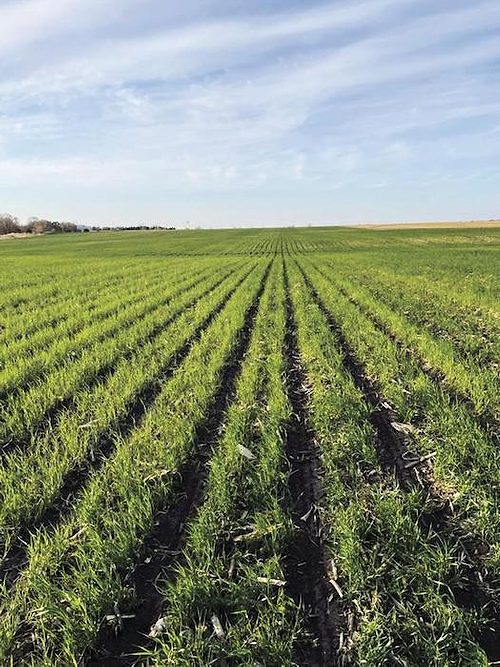Matt Grosshans was tired of seeing his strip-tilled fields washed out with heavy spring rains. As extreme weather patterns started impacting his operation, the Hamilton County, Neb., farmer realized reduced tillage, cover crops and crop rotations were vital to maintaining his soil.
“Last year we got a 6-inch rain in early May in an hour," Grosshans told the York News Times. "Extreme heavy rainfall really needs good soil structure or else there’s erosion. I am interested in the long-term sustainability of the soil, especially for fields that I farm that are more challenging.”
Grosshans turned to the Upper Big Blue Natural Resources District (NRD) and the NRCS for help with funding and planting cover crops. He planted 350 acres of rye after corn and soybeans in fall 2021.
He looked at the first year as an experiment to help him evaluate what would work for his operation. He broadcasted some of the seed and tilled in the rest, which gave him mixed results. He plants to use a no-till drill to seed the cover crops in the future.
Overall, he says he had "really good luck" in year 1. The rye that got established got good growth and its root system will provide some stability to the soil if heavy rains come. In windy April, his soil stayed in place, while soil on conventionally tilled fields nearby blew away and washed out in heavy rain.
Moisture plays a crucial role in getting the cover crops established, and Grosshans suggests irrigating after planting to ensure germination if there isn't a timely rain.
Cover crops proved to be good for weed suppression on his acres, providing a lot of ground cover once terminated. The ground cover helps the soil from drying out and eroding in drought periods, too. The covers may take up more moisture in the spring, but in wet weather, it helps the soil dry out quicker and the farmer get in the field sooner. As the biomass decomposes, it feeds the microbes in the soil, which Grosshans predicts will improve productivity in the future.
“I like the idea of having something growing year-round," Grosshans says. "Soil stability and overall soil health are going to be better. It really needs to be coupled with the no till, which is what we’re trying to do on a couple of these farms where we’ve had long-term erosion problems."
It's been a worthwhile switch so far, although it didn't always come easily. He says getting good consistent growth without drilling or doing tillage is challenging, and timing can be difficult, depending on what commodity crop is grown in a particular field. Cover crops are hard to plant in the fall behind corn, which may not be harvested until early November in northern Nebraska. Planing after seed corn and soybeans is easier with their earlier harvest dates.
Even with the challenges, he recommends other farmers give cover crops a try where it makes sense. A lot of his neighbors have been curious about his covers, and he says he's had some good conversations about the challenges and benefits of making cover crops work.
"It's hard to deny that it's going to be more work," Grosshans say. "Even if you have someone else apply the cover crops, it's now more management. Pinpoint acres that you feel would really benefit and then just jump in and try it on a small scale, one field or two fields, something that’s easily manageable that’s not going to get away from you."
His funding from the NRCS and NRD offsets costs for 5 years while he establishes practices, which makes it easier to implement covers. The financial assistance helps with seed, application and termination costs associated with cover crops. He takes a strategic approach to identify acres where cover crops and other soil-saving practices will have the biggest immediate impact.
“The farms that are susceptible to eroding, those are the ones we are working to convert to a minimum or no-till, or spot tillage, and add cover crops. Reducing erosion, that’s the end goal,” Grosshans says.





Post a comment
Report Abusive Comment